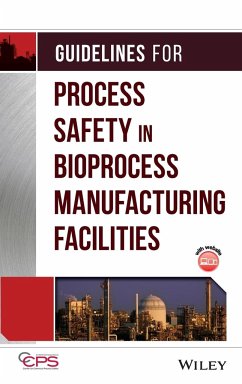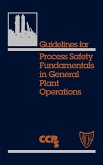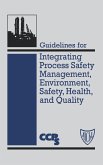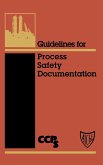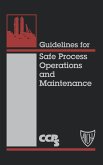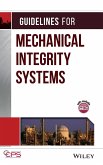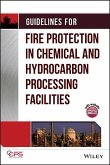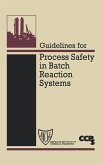Center for Chemical Process Safety (CCPS)
GL Bioprocess Safety
Center for Chemical Process Safety (CCPS)
GL Bioprocess Safety
- Gebundenes Buch
- Merkliste
- Auf die Merkliste
- Bewerten Bewerten
- Teilen
- Produkt teilen
- Produkterinnerung
- Produkterinnerung
This book helps advance process safety in a key area of interest. Currently, no literature exists which is solely dedicated to process safety for the bioprocessing industry. There are texts, guidelines, and standards on biosafety at the laboratory level and for industrial hygiene, but no guidelines for large-scale production facilities. In fact, biosafety is largely defined as a field that promotes safe laboratory practices, procedures and use of containment equipment and facilities. Additionally, biomedical engineers, biologists, or other professionals without chemical engineering training or…mehr
Andere Kunden interessierten sich auch für
![Guidelines for Process Safety Fundamentals in General Plant Operations Guidelines for Process Safety Fundamentals in General Plant Operations]() Center for Chemical Process Safety (CCPS)Guidelines for Process Safety Fundamentals in General Plant Operations108,99 €
Center for Chemical Process Safety (CCPS)Guidelines for Process Safety Fundamentals in General Plant Operations108,99 €![Guidelines for Integrating Process Safety Management, Environment, Safety, Health, and Quality Guidelines for Integrating Process Safety Management, Environment, Safety, Health, and Quality]() Center for Chemical Process Safety (CCPS)Guidelines for Integrating Process Safety Management, Environment, Safety, Health, and Quality204,99 €
Center for Chemical Process Safety (CCPS)Guidelines for Integrating Process Safety Management, Environment, Safety, Health, and Quality204,99 €![Guidelines for Process Safety Documentation Guidelines for Process Safety Documentation]() Center for Chemical Process Safety (CCPS)Guidelines for Process Safety Documentation190,99 €
Center for Chemical Process Safety (CCPS)Guidelines for Process Safety Documentation190,99 €![Guidelines for Safe Process Operations and Maintenance Guidelines for Safe Process Operations and Maintenance]() Center for Chemical Process Safety (CCPS)Guidelines for Safe Process Operations and Maintenance158,99 €
Center for Chemical Process Safety (CCPS)Guidelines for Safe Process Operations and Maintenance158,99 €![Guidelines for Mechanical Integrity Systems Guidelines for Mechanical Integrity Systems]() Center for Chemical Process Safety (CCPS)Guidelines for Mechanical Integrity Systems205,99 €
Center for Chemical Process Safety (CCPS)Guidelines for Mechanical Integrity Systems205,99 €![Guidelines for Fire Protection in Chemical, Petrochemical, and Hydrocarbon Processing Facilities Guidelines for Fire Protection in Chemical, Petrochemical, and Hydrocarbon Processing Facilities]() Ccps (Center For Chemical Process Safety)Guidelines for Fire Protection in Chemical, Petrochemical, and Hydrocarbon Processing Facilities312,99 €
Ccps (Center For Chemical Process Safety)Guidelines for Fire Protection in Chemical, Petrochemical, and Hydrocarbon Processing Facilities312,99 €![Guidelines for Process Safety in Batch Reaction Systems Guidelines for Process Safety in Batch Reaction Systems]() Center for Chemical Process Safety (CCPS)Guidelines for Process Safety in Batch Reaction Systems194,99 €
Center for Chemical Process Safety (CCPS)Guidelines for Process Safety in Batch Reaction Systems194,99 €-
-
-
This book helps advance process safety in a key area of interest. Currently, no literature exists which is solely dedicated to process safety for the bioprocessing industry. There are texts, guidelines, and standards on biosafety at the laboratory level and for industrial hygiene, but no guidelines for large-scale production facilities. In fact, biosafety is largely defined as a field that promotes safe laboratory practices, procedures and use of containment equipment and facilities. Additionally, biomedical engineers, biologists, or other professionals without chemical engineering training or knowledge of inherently safe design are designing many of these facilities.
Hinweis: Dieser Artikel kann nur an eine deutsche Lieferadresse ausgeliefert werden.
Hinweis: Dieser Artikel kann nur an eine deutsche Lieferadresse ausgeliefert werden.
Produktdetails
- Produktdetails
- Verlag: Wiley
- Seitenzahl: 248
- Erscheinungstermin: 23. November 2010
- Englisch
- Abmessung: 240mm x 161mm x 18mm
- Gewicht: 539g
- ISBN-13: 9780470251492
- ISBN-10: 0470251492
- Artikelnr.: 29337148
- Herstellerkennzeichnung
- Libri GmbH
- Europaallee 1
- 36244 Bad Hersfeld
- gpsr@libri.de
- Verlag: Wiley
- Seitenzahl: 248
- Erscheinungstermin: 23. November 2010
- Englisch
- Abmessung: 240mm x 161mm x 18mm
- Gewicht: 539g
- ISBN-13: 9780470251492
- ISBN-10: 0470251492
- Artikelnr.: 29337148
- Herstellerkennzeichnung
- Libri GmbH
- Europaallee 1
- 36244 Bad Hersfeld
- gpsr@libri.de
Since 1985, the Center for Chemical Process Safety (CCPS) has been the world leader in developing and disseminating information on process safety management and technology. CCPS, an industry technology alliance of the American Institute of Chemical Engineers (AIChE), has published over 80 books in its process safety guidelines and process safety concepts series, and over 100 training modules through its Safety in Chemical Engineering Education (SACHE) series.
List of Tables xi
List of Figures xiii
Items on the Web Accompanying This Book xv
Acknowledgements xvii
Preface xix
1 INTRODUCTION 1
1.1 Bioprocess Engineering Information Transfer and Management Practices 3
1.2 The Need for Bioprocess Safety Management Systems 7
1.2.2 Bioprocessing Incidents and Releases 8
1.3 Our Target Audience 14
1.4 How to use this Guideline 15
2 AN OVERVIEW OF THE BIOPROCESSING INDUSTRY 17
2.1 Bioprocessing's History 17
2.1.1 Bioprocessing's Historical Advancement 18
2.1.1.1 Microbiological Advancements 18
2.1.1.2 Food Science and Food Process Technology Advancements 19
2.1.1.3 Genetic Advancements 19
2.1.1.4 Future Bioprocessing Developments 20
2.2 Industrial Applications 20
2.2.1 Processes 21
2.2.2 Products 21
2.3 The Bioprocess Lifecycle 22
2.3.1 Discovery 23
2.3.2 Development Phase: Laboratory and Pilot Plant 23
2.3.3 Scale-up Phase 24
2.3.4 Upstream Operations and Downstream Operations 26
2.3.4.1 Inoculation / Seed and Production Biosafety Containment and
Production Risk 27
2.3.4.2 Fermentation / Cell Culture 31
2.3.4.3 Scale of Manufacturing 36
2.3.5 General Biosafety Recommendations for Large Scale Work 38
2.3.5.1 Facility Design 39
2.3.5.2 Equipment Design 39
2.3.5.3 Cleaning, Inactivation, and Sterilization 41
2.3.5.4 Maintenance 42
2.3.5.5 Air and Gas Emissions 42
2.3.5.6 Waste Handling 42
2.3.5.7 Accidental Release 43
2.3.6 Product Safety Information 43
2.3.6.1 Product Handling 44
2.3.6.2 Material Disposal 44
2.3.63 Disposable Process Technology 44
2.3.7 Outsourced Manufacturing Concerns 45
3 BIOPROCESSING SAFETY MANAGEMENT PRACTICES 47
3.1 Sample Approach 48
3.1.2 Develop and Document a System to Manage Bioprocess Safety Hazards 50
3.1.3 Appoint a Biological Safety Officer 50
3.1.4 Collect Bioprocess Hazard Information 51
3.1.5 Identify Bioprocess Safety Hazards 51
3.1.5.1 Point of Decision 51
3.1.6 Assess Bioprocess Safety Risks and Assign Bioprocess Safety Hazard
Level 52
3.1.7 Identify Bioprocess Controls and Risk Management Options 52
3.1.8 Document Bioprocess Safety Hazard Risks and Management Decisions 53
3.1.9 Communicate and Train on Bioprocess Safety Hazards 53
3.1.10 Investigate & Learn from Bioprocess Incidents 53
3.1.11 Review, Audit, Manage Change, and Improve Hazard Management
Practices and Program 54
3.2 Existing Management Systems 54
3.2.1 Product Stewardship for Byproducts 61
3.3 Establishing a Bioprocess Safety Management System 62
3.3.1 Select a Management System Model Based Upon Your Needs 63
3.3.2 Identifying the Elements that Apply to Your Operations 64
3.3.3 Establish a Review and Approval Cycle for the Documents 65
3.3.4 Rolling Out the Management System to the Users 66
3.4 Biosafety Training for the Workforce 67
3.5 Investigating Incidents 69
3.5.1 A Generic Procedure for Initial Biohazard Incident Response 71
3.6 Managing Change 75
3.7 Reviewing and Auditing for Continuous Improvement 76
3.8 Applying Behavior-Based Safety to Bioprocesses 76
4.IDENTIFYING BIOPROCESS HAZARDS 79
4.1 Key Considerations for Assessing Risk to Manage Bioprocess Safety 79
4.1.1 Testing for Bioactivity 79
4.1.2 Non-biological Hazards 80
4.2 Bioprocess Risk Assessment 80
4.2.1 Three Types of Assessment 80
4.2.2 Agent Considerations 80
4.2.3 Process Considerations 81
4.2.4 Environmental Considerations 82
4.2.5 Microorganisms 83
4.3 Recombinant Organisms 85
4.4 Cell Culture 86
5 BIOPROCESS DESIGN CONSIDERATIONS AND UNIT OPERATIONS 89
5.1 Physical Plant Design 89
5.1.1 Architectural Aspects 90
5.1.1.1 Finishes and Materials 90
5.1.1.2 Layout Strategies 91
5.1.1.3 People and Material Flow 94
5.1.1.4 Non-bio logical Hazards 94
5.1.1.5 Seismic and Building Loads 96
5.1.1.6 Hardened Construction 97
5.1.1.7 Equipment Mezzanines and Subfloors 97
5.1.1.8 Heating, Ventilation, and Air Conditioning Aspects 98
(a) Supply and Exhaust Systems 98
(b) Special Exhaust Stream Mitigation 100
(c) HVAC Issues from a Biosafety Perspective 101
(d) Microenvironments 103
(e) Cascading Pressure Differentials 105
(f) Containment versus Clean Room Environments 107
5.1.1.9 Waste and Waste Treatment 109
5.1.1.10 Process Support Systems: High Purity Water 112
5.1.1.11 Process Support Systems: Hand Washing Sinks and Personnel showers
112
5.1.2 Plant Siting Issues 113
5.1.2.1 Zoning & Permitting 113
5.1.2.2 Regional Environmental Agencies and Environmental Impact Reports
113
5.1.2.3 Building and Site Security 114
5.2 Bioprocess Unit Operations 116
5.2.1 General Equipment Design Considerations 117
5.2.2 Closed-System Design 118
5.2.2.2 Impact on Operations 123
5.2.3 Upstream Equipment and Facility Design 124
5.2.3.1 Additional Upstream Design Considerations 124
5.2.3.2 Equipment and Facility Integration 127
5.2.3.3 Production Segregation and Flows 127
5.2.3.4 Segregation from a Biosafety Perspective 129
5.2.3.5 Cleaning the Equipment 130
5.2.4.1 Harvest and Recovery 134
5.2.4.2 Centrifugation 134
5.2.4.3 Filtration 135
5.2.4.4 Chromatography 137
5.2.5 Facility Support Issues 139
5.2.6 Biosafety for Personnel: SOP, Protocols, and PPE 140
6 THE EFFECTS OF EMERGING TECHNOLOGY ON BIOPROCESSING RISK MANAGEMENT 143
6.1 Researching and Staying Informed 143
6.1.1 Biopharmaceutical 144
6.1 .1 .1 Drug Discovery and Development 144
6.1.1.2 Gene-based Pharmaceuticals 144
6.1.1.3 Drug Delivery Research 146
6.1.2 Renewable-resources 147
6.1.3 Environmental 148
6.1.3.1 Bioprocessing and Waste Management 148
6.2 Communicating the Impacts of New Technology 149
6.2.1 Industry (Communication at Your Site) 150
APPENDIX A - REFERENCES & SELECTED REGULATIONS 153
APPENDIX B - LARGE SCALE BIOSAFETY GUIDELINES 161
APPENDIX C - A GENERIC LABORATORY/LARGE SCALE BIOSAFETY CHECKLIST 177
APPENDIX D - BIOLOGICAL ASSESSMENT QUESTIONNAIRE & BIOPROCESS SAFETY
CHECKLIST 179
APPENDIX E - BIOPROCESS FACILITY AUDIT CHECKLIST 189
APPENDIX F - DIRECTIVE 2000/54/EC OF THE EUROPEAN PARLIAMENT AND OF THE
COUNCIL 199
APPENDIX G - COMPARISON OF GOOD LARGE SCALE PRACTICE (GLSP) AND BIOSAFETY
LEVEL (BL) - LARGE SCALE (LS) PRACTICE 203
GLOSSARY 209
ACRONYMS AND ABBREVIATIONS 217
INDEX 221
List of Figures xiii
Items on the Web Accompanying This Book xv
Acknowledgements xvii
Preface xix
1 INTRODUCTION 1
1.1 Bioprocess Engineering Information Transfer and Management Practices 3
1.2 The Need for Bioprocess Safety Management Systems 7
1.2.2 Bioprocessing Incidents and Releases 8
1.3 Our Target Audience 14
1.4 How to use this Guideline 15
2 AN OVERVIEW OF THE BIOPROCESSING INDUSTRY 17
2.1 Bioprocessing's History 17
2.1.1 Bioprocessing's Historical Advancement 18
2.1.1.1 Microbiological Advancements 18
2.1.1.2 Food Science and Food Process Technology Advancements 19
2.1.1.3 Genetic Advancements 19
2.1.1.4 Future Bioprocessing Developments 20
2.2 Industrial Applications 20
2.2.1 Processes 21
2.2.2 Products 21
2.3 The Bioprocess Lifecycle 22
2.3.1 Discovery 23
2.3.2 Development Phase: Laboratory and Pilot Plant 23
2.3.3 Scale-up Phase 24
2.3.4 Upstream Operations and Downstream Operations 26
2.3.4.1 Inoculation / Seed and Production Biosafety Containment and
Production Risk 27
2.3.4.2 Fermentation / Cell Culture 31
2.3.4.3 Scale of Manufacturing 36
2.3.5 General Biosafety Recommendations for Large Scale Work 38
2.3.5.1 Facility Design 39
2.3.5.2 Equipment Design 39
2.3.5.3 Cleaning, Inactivation, and Sterilization 41
2.3.5.4 Maintenance 42
2.3.5.5 Air and Gas Emissions 42
2.3.5.6 Waste Handling 42
2.3.5.7 Accidental Release 43
2.3.6 Product Safety Information 43
2.3.6.1 Product Handling 44
2.3.6.2 Material Disposal 44
2.3.63 Disposable Process Technology 44
2.3.7 Outsourced Manufacturing Concerns 45
3 BIOPROCESSING SAFETY MANAGEMENT PRACTICES 47
3.1 Sample Approach 48
3.1.2 Develop and Document a System to Manage Bioprocess Safety Hazards 50
3.1.3 Appoint a Biological Safety Officer 50
3.1.4 Collect Bioprocess Hazard Information 51
3.1.5 Identify Bioprocess Safety Hazards 51
3.1.5.1 Point of Decision 51
3.1.6 Assess Bioprocess Safety Risks and Assign Bioprocess Safety Hazard
Level 52
3.1.7 Identify Bioprocess Controls and Risk Management Options 52
3.1.8 Document Bioprocess Safety Hazard Risks and Management Decisions 53
3.1.9 Communicate and Train on Bioprocess Safety Hazards 53
3.1.10 Investigate & Learn from Bioprocess Incidents 53
3.1.11 Review, Audit, Manage Change, and Improve Hazard Management
Practices and Program 54
3.2 Existing Management Systems 54
3.2.1 Product Stewardship for Byproducts 61
3.3 Establishing a Bioprocess Safety Management System 62
3.3.1 Select a Management System Model Based Upon Your Needs 63
3.3.2 Identifying the Elements that Apply to Your Operations 64
3.3.3 Establish a Review and Approval Cycle for the Documents 65
3.3.4 Rolling Out the Management System to the Users 66
3.4 Biosafety Training for the Workforce 67
3.5 Investigating Incidents 69
3.5.1 A Generic Procedure for Initial Biohazard Incident Response 71
3.6 Managing Change 75
3.7 Reviewing and Auditing for Continuous Improvement 76
3.8 Applying Behavior-Based Safety to Bioprocesses 76
4.IDENTIFYING BIOPROCESS HAZARDS 79
4.1 Key Considerations for Assessing Risk to Manage Bioprocess Safety 79
4.1.1 Testing for Bioactivity 79
4.1.2 Non-biological Hazards 80
4.2 Bioprocess Risk Assessment 80
4.2.1 Three Types of Assessment 80
4.2.2 Agent Considerations 80
4.2.3 Process Considerations 81
4.2.4 Environmental Considerations 82
4.2.5 Microorganisms 83
4.3 Recombinant Organisms 85
4.4 Cell Culture 86
5 BIOPROCESS DESIGN CONSIDERATIONS AND UNIT OPERATIONS 89
5.1 Physical Plant Design 89
5.1.1 Architectural Aspects 90
5.1.1.1 Finishes and Materials 90
5.1.1.2 Layout Strategies 91
5.1.1.3 People and Material Flow 94
5.1.1.4 Non-bio logical Hazards 94
5.1.1.5 Seismic and Building Loads 96
5.1.1.6 Hardened Construction 97
5.1.1.7 Equipment Mezzanines and Subfloors 97
5.1.1.8 Heating, Ventilation, and Air Conditioning Aspects 98
(a) Supply and Exhaust Systems 98
(b) Special Exhaust Stream Mitigation 100
(c) HVAC Issues from a Biosafety Perspective 101
(d) Microenvironments 103
(e) Cascading Pressure Differentials 105
(f) Containment versus Clean Room Environments 107
5.1.1.9 Waste and Waste Treatment 109
5.1.1.10 Process Support Systems: High Purity Water 112
5.1.1.11 Process Support Systems: Hand Washing Sinks and Personnel showers
112
5.1.2 Plant Siting Issues 113
5.1.2.1 Zoning & Permitting 113
5.1.2.2 Regional Environmental Agencies and Environmental Impact Reports
113
5.1.2.3 Building and Site Security 114
5.2 Bioprocess Unit Operations 116
5.2.1 General Equipment Design Considerations 117
5.2.2 Closed-System Design 118
5.2.2.2 Impact on Operations 123
5.2.3 Upstream Equipment and Facility Design 124
5.2.3.1 Additional Upstream Design Considerations 124
5.2.3.2 Equipment and Facility Integration 127
5.2.3.3 Production Segregation and Flows 127
5.2.3.4 Segregation from a Biosafety Perspective 129
5.2.3.5 Cleaning the Equipment 130
5.2.4.1 Harvest and Recovery 134
5.2.4.2 Centrifugation 134
5.2.4.3 Filtration 135
5.2.4.4 Chromatography 137
5.2.5 Facility Support Issues 139
5.2.6 Biosafety for Personnel: SOP, Protocols, and PPE 140
6 THE EFFECTS OF EMERGING TECHNOLOGY ON BIOPROCESSING RISK MANAGEMENT 143
6.1 Researching and Staying Informed 143
6.1.1 Biopharmaceutical 144
6.1 .1 .1 Drug Discovery and Development 144
6.1.1.2 Gene-based Pharmaceuticals 144
6.1.1.3 Drug Delivery Research 146
6.1.2 Renewable-resources 147
6.1.3 Environmental 148
6.1.3.1 Bioprocessing and Waste Management 148
6.2 Communicating the Impacts of New Technology 149
6.2.1 Industry (Communication at Your Site) 150
APPENDIX A - REFERENCES & SELECTED REGULATIONS 153
APPENDIX B - LARGE SCALE BIOSAFETY GUIDELINES 161
APPENDIX C - A GENERIC LABORATORY/LARGE SCALE BIOSAFETY CHECKLIST 177
APPENDIX D - BIOLOGICAL ASSESSMENT QUESTIONNAIRE & BIOPROCESS SAFETY
CHECKLIST 179
APPENDIX E - BIOPROCESS FACILITY AUDIT CHECKLIST 189
APPENDIX F - DIRECTIVE 2000/54/EC OF THE EUROPEAN PARLIAMENT AND OF THE
COUNCIL 199
APPENDIX G - COMPARISON OF GOOD LARGE SCALE PRACTICE (GLSP) AND BIOSAFETY
LEVEL (BL) - LARGE SCALE (LS) PRACTICE 203
GLOSSARY 209
ACRONYMS AND ABBREVIATIONS 217
INDEX 221
List of Tables xi
List of Figures xiii
Items on the Web Accompanying This Book xv
Acknowledgements xvii
Preface xix
1 INTRODUCTION 1
1.1 Bioprocess Engineering Information Transfer and Management Practices 3
1.2 The Need for Bioprocess Safety Management Systems 7
1.2.2 Bioprocessing Incidents and Releases 8
1.3 Our Target Audience 14
1.4 How to use this Guideline 15
2 AN OVERVIEW OF THE BIOPROCESSING INDUSTRY 17
2.1 Bioprocessing's History 17
2.1.1 Bioprocessing's Historical Advancement 18
2.1.1.1 Microbiological Advancements 18
2.1.1.2 Food Science and Food Process Technology Advancements 19
2.1.1.3 Genetic Advancements 19
2.1.1.4 Future Bioprocessing Developments 20
2.2 Industrial Applications 20
2.2.1 Processes 21
2.2.2 Products 21
2.3 The Bioprocess Lifecycle 22
2.3.1 Discovery 23
2.3.2 Development Phase: Laboratory and Pilot Plant 23
2.3.3 Scale-up Phase 24
2.3.4 Upstream Operations and Downstream Operations 26
2.3.4.1 Inoculation / Seed and Production Biosafety Containment and
Production Risk 27
2.3.4.2 Fermentation / Cell Culture 31
2.3.4.3 Scale of Manufacturing 36
2.3.5 General Biosafety Recommendations for Large Scale Work 38
2.3.5.1 Facility Design 39
2.3.5.2 Equipment Design 39
2.3.5.3 Cleaning, Inactivation, and Sterilization 41
2.3.5.4 Maintenance 42
2.3.5.5 Air and Gas Emissions 42
2.3.5.6 Waste Handling 42
2.3.5.7 Accidental Release 43
2.3.6 Product Safety Information 43
2.3.6.1 Product Handling 44
2.3.6.2 Material Disposal 44
2.3.63 Disposable Process Technology 44
2.3.7 Outsourced Manufacturing Concerns 45
3 BIOPROCESSING SAFETY MANAGEMENT PRACTICES 47
3.1 Sample Approach 48
3.1.2 Develop and Document a System to Manage Bioprocess Safety Hazards 50
3.1.3 Appoint a Biological Safety Officer 50
3.1.4 Collect Bioprocess Hazard Information 51
3.1.5 Identify Bioprocess Safety Hazards 51
3.1.5.1 Point of Decision 51
3.1.6 Assess Bioprocess Safety Risks and Assign Bioprocess Safety Hazard
Level 52
3.1.7 Identify Bioprocess Controls and Risk Management Options 52
3.1.8 Document Bioprocess Safety Hazard Risks and Management Decisions 53
3.1.9 Communicate and Train on Bioprocess Safety Hazards 53
3.1.10 Investigate & Learn from Bioprocess Incidents 53
3.1.11 Review, Audit, Manage Change, and Improve Hazard Management
Practices and Program 54
3.2 Existing Management Systems 54
3.2.1 Product Stewardship for Byproducts 61
3.3 Establishing a Bioprocess Safety Management System 62
3.3.1 Select a Management System Model Based Upon Your Needs 63
3.3.2 Identifying the Elements that Apply to Your Operations 64
3.3.3 Establish a Review and Approval Cycle for the Documents 65
3.3.4 Rolling Out the Management System to the Users 66
3.4 Biosafety Training for the Workforce 67
3.5 Investigating Incidents 69
3.5.1 A Generic Procedure for Initial Biohazard Incident Response 71
3.6 Managing Change 75
3.7 Reviewing and Auditing for Continuous Improvement 76
3.8 Applying Behavior-Based Safety to Bioprocesses 76
4.IDENTIFYING BIOPROCESS HAZARDS 79
4.1 Key Considerations for Assessing Risk to Manage Bioprocess Safety 79
4.1.1 Testing for Bioactivity 79
4.1.2 Non-biological Hazards 80
4.2 Bioprocess Risk Assessment 80
4.2.1 Three Types of Assessment 80
4.2.2 Agent Considerations 80
4.2.3 Process Considerations 81
4.2.4 Environmental Considerations 82
4.2.5 Microorganisms 83
4.3 Recombinant Organisms 85
4.4 Cell Culture 86
5 BIOPROCESS DESIGN CONSIDERATIONS AND UNIT OPERATIONS 89
5.1 Physical Plant Design 89
5.1.1 Architectural Aspects 90
5.1.1.1 Finishes and Materials 90
5.1.1.2 Layout Strategies 91
5.1.1.3 People and Material Flow 94
5.1.1.4 Non-bio logical Hazards 94
5.1.1.5 Seismic and Building Loads 96
5.1.1.6 Hardened Construction 97
5.1.1.7 Equipment Mezzanines and Subfloors 97
5.1.1.8 Heating, Ventilation, and Air Conditioning Aspects 98
(a) Supply and Exhaust Systems 98
(b) Special Exhaust Stream Mitigation 100
(c) HVAC Issues from a Biosafety Perspective 101
(d) Microenvironments 103
(e) Cascading Pressure Differentials 105
(f) Containment versus Clean Room Environments 107
5.1.1.9 Waste and Waste Treatment 109
5.1.1.10 Process Support Systems: High Purity Water 112
5.1.1.11 Process Support Systems: Hand Washing Sinks and Personnel showers
112
5.1.2 Plant Siting Issues 113
5.1.2.1 Zoning & Permitting 113
5.1.2.2 Regional Environmental Agencies and Environmental Impact Reports
113
5.1.2.3 Building and Site Security 114
5.2 Bioprocess Unit Operations 116
5.2.1 General Equipment Design Considerations 117
5.2.2 Closed-System Design 118
5.2.2.2 Impact on Operations 123
5.2.3 Upstream Equipment and Facility Design 124
5.2.3.1 Additional Upstream Design Considerations 124
5.2.3.2 Equipment and Facility Integration 127
5.2.3.3 Production Segregation and Flows 127
5.2.3.4 Segregation from a Biosafety Perspective 129
5.2.3.5 Cleaning the Equipment 130
5.2.4.1 Harvest and Recovery 134
5.2.4.2 Centrifugation 134
5.2.4.3 Filtration 135
5.2.4.4 Chromatography 137
5.2.5 Facility Support Issues 139
5.2.6 Biosafety for Personnel: SOP, Protocols, and PPE 140
6 THE EFFECTS OF EMERGING TECHNOLOGY ON BIOPROCESSING RISK MANAGEMENT 143
6.1 Researching and Staying Informed 143
6.1.1 Biopharmaceutical 144
6.1 .1 .1 Drug Discovery and Development 144
6.1.1.2 Gene-based Pharmaceuticals 144
6.1.1.3 Drug Delivery Research 146
6.1.2 Renewable-resources 147
6.1.3 Environmental 148
6.1.3.1 Bioprocessing and Waste Management 148
6.2 Communicating the Impacts of New Technology 149
6.2.1 Industry (Communication at Your Site) 150
APPENDIX A - REFERENCES & SELECTED REGULATIONS 153
APPENDIX B - LARGE SCALE BIOSAFETY GUIDELINES 161
APPENDIX C - A GENERIC LABORATORY/LARGE SCALE BIOSAFETY CHECKLIST 177
APPENDIX D - BIOLOGICAL ASSESSMENT QUESTIONNAIRE & BIOPROCESS SAFETY
CHECKLIST 179
APPENDIX E - BIOPROCESS FACILITY AUDIT CHECKLIST 189
APPENDIX F - DIRECTIVE 2000/54/EC OF THE EUROPEAN PARLIAMENT AND OF THE
COUNCIL 199
APPENDIX G - COMPARISON OF GOOD LARGE SCALE PRACTICE (GLSP) AND BIOSAFETY
LEVEL (BL) - LARGE SCALE (LS) PRACTICE 203
GLOSSARY 209
ACRONYMS AND ABBREVIATIONS 217
INDEX 221
List of Figures xiii
Items on the Web Accompanying This Book xv
Acknowledgements xvii
Preface xix
1 INTRODUCTION 1
1.1 Bioprocess Engineering Information Transfer and Management Practices 3
1.2 The Need for Bioprocess Safety Management Systems 7
1.2.2 Bioprocessing Incidents and Releases 8
1.3 Our Target Audience 14
1.4 How to use this Guideline 15
2 AN OVERVIEW OF THE BIOPROCESSING INDUSTRY 17
2.1 Bioprocessing's History 17
2.1.1 Bioprocessing's Historical Advancement 18
2.1.1.1 Microbiological Advancements 18
2.1.1.2 Food Science and Food Process Technology Advancements 19
2.1.1.3 Genetic Advancements 19
2.1.1.4 Future Bioprocessing Developments 20
2.2 Industrial Applications 20
2.2.1 Processes 21
2.2.2 Products 21
2.3 The Bioprocess Lifecycle 22
2.3.1 Discovery 23
2.3.2 Development Phase: Laboratory and Pilot Plant 23
2.3.3 Scale-up Phase 24
2.3.4 Upstream Operations and Downstream Operations 26
2.3.4.1 Inoculation / Seed and Production Biosafety Containment and
Production Risk 27
2.3.4.2 Fermentation / Cell Culture 31
2.3.4.3 Scale of Manufacturing 36
2.3.5 General Biosafety Recommendations for Large Scale Work 38
2.3.5.1 Facility Design 39
2.3.5.2 Equipment Design 39
2.3.5.3 Cleaning, Inactivation, and Sterilization 41
2.3.5.4 Maintenance 42
2.3.5.5 Air and Gas Emissions 42
2.3.5.6 Waste Handling 42
2.3.5.7 Accidental Release 43
2.3.6 Product Safety Information 43
2.3.6.1 Product Handling 44
2.3.6.2 Material Disposal 44
2.3.63 Disposable Process Technology 44
2.3.7 Outsourced Manufacturing Concerns 45
3 BIOPROCESSING SAFETY MANAGEMENT PRACTICES 47
3.1 Sample Approach 48
3.1.2 Develop and Document a System to Manage Bioprocess Safety Hazards 50
3.1.3 Appoint a Biological Safety Officer 50
3.1.4 Collect Bioprocess Hazard Information 51
3.1.5 Identify Bioprocess Safety Hazards 51
3.1.5.1 Point of Decision 51
3.1.6 Assess Bioprocess Safety Risks and Assign Bioprocess Safety Hazard
Level 52
3.1.7 Identify Bioprocess Controls and Risk Management Options 52
3.1.8 Document Bioprocess Safety Hazard Risks and Management Decisions 53
3.1.9 Communicate and Train on Bioprocess Safety Hazards 53
3.1.10 Investigate & Learn from Bioprocess Incidents 53
3.1.11 Review, Audit, Manage Change, and Improve Hazard Management
Practices and Program 54
3.2 Existing Management Systems 54
3.2.1 Product Stewardship for Byproducts 61
3.3 Establishing a Bioprocess Safety Management System 62
3.3.1 Select a Management System Model Based Upon Your Needs 63
3.3.2 Identifying the Elements that Apply to Your Operations 64
3.3.3 Establish a Review and Approval Cycle for the Documents 65
3.3.4 Rolling Out the Management System to the Users 66
3.4 Biosafety Training for the Workforce 67
3.5 Investigating Incidents 69
3.5.1 A Generic Procedure for Initial Biohazard Incident Response 71
3.6 Managing Change 75
3.7 Reviewing and Auditing for Continuous Improvement 76
3.8 Applying Behavior-Based Safety to Bioprocesses 76
4.IDENTIFYING BIOPROCESS HAZARDS 79
4.1 Key Considerations for Assessing Risk to Manage Bioprocess Safety 79
4.1.1 Testing for Bioactivity 79
4.1.2 Non-biological Hazards 80
4.2 Bioprocess Risk Assessment 80
4.2.1 Three Types of Assessment 80
4.2.2 Agent Considerations 80
4.2.3 Process Considerations 81
4.2.4 Environmental Considerations 82
4.2.5 Microorganisms 83
4.3 Recombinant Organisms 85
4.4 Cell Culture 86
5 BIOPROCESS DESIGN CONSIDERATIONS AND UNIT OPERATIONS 89
5.1 Physical Plant Design 89
5.1.1 Architectural Aspects 90
5.1.1.1 Finishes and Materials 90
5.1.1.2 Layout Strategies 91
5.1.1.3 People and Material Flow 94
5.1.1.4 Non-bio logical Hazards 94
5.1.1.5 Seismic and Building Loads 96
5.1.1.6 Hardened Construction 97
5.1.1.7 Equipment Mezzanines and Subfloors 97
5.1.1.8 Heating, Ventilation, and Air Conditioning Aspects 98
(a) Supply and Exhaust Systems 98
(b) Special Exhaust Stream Mitigation 100
(c) HVAC Issues from a Biosafety Perspective 101
(d) Microenvironments 103
(e) Cascading Pressure Differentials 105
(f) Containment versus Clean Room Environments 107
5.1.1.9 Waste and Waste Treatment 109
5.1.1.10 Process Support Systems: High Purity Water 112
5.1.1.11 Process Support Systems: Hand Washing Sinks and Personnel showers
112
5.1.2 Plant Siting Issues 113
5.1.2.1 Zoning & Permitting 113
5.1.2.2 Regional Environmental Agencies and Environmental Impact Reports
113
5.1.2.3 Building and Site Security 114
5.2 Bioprocess Unit Operations 116
5.2.1 General Equipment Design Considerations 117
5.2.2 Closed-System Design 118
5.2.2.2 Impact on Operations 123
5.2.3 Upstream Equipment and Facility Design 124
5.2.3.1 Additional Upstream Design Considerations 124
5.2.3.2 Equipment and Facility Integration 127
5.2.3.3 Production Segregation and Flows 127
5.2.3.4 Segregation from a Biosafety Perspective 129
5.2.3.5 Cleaning the Equipment 130
5.2.4.1 Harvest and Recovery 134
5.2.4.2 Centrifugation 134
5.2.4.3 Filtration 135
5.2.4.4 Chromatography 137
5.2.5 Facility Support Issues 139
5.2.6 Biosafety for Personnel: SOP, Protocols, and PPE 140
6 THE EFFECTS OF EMERGING TECHNOLOGY ON BIOPROCESSING RISK MANAGEMENT 143
6.1 Researching and Staying Informed 143
6.1.1 Biopharmaceutical 144
6.1 .1 .1 Drug Discovery and Development 144
6.1.1.2 Gene-based Pharmaceuticals 144
6.1.1.3 Drug Delivery Research 146
6.1.2 Renewable-resources 147
6.1.3 Environmental 148
6.1.3.1 Bioprocessing and Waste Management 148
6.2 Communicating the Impacts of New Technology 149
6.2.1 Industry (Communication at Your Site) 150
APPENDIX A - REFERENCES & SELECTED REGULATIONS 153
APPENDIX B - LARGE SCALE BIOSAFETY GUIDELINES 161
APPENDIX C - A GENERIC LABORATORY/LARGE SCALE BIOSAFETY CHECKLIST 177
APPENDIX D - BIOLOGICAL ASSESSMENT QUESTIONNAIRE & BIOPROCESS SAFETY
CHECKLIST 179
APPENDIX E - BIOPROCESS FACILITY AUDIT CHECKLIST 189
APPENDIX F - DIRECTIVE 2000/54/EC OF THE EUROPEAN PARLIAMENT AND OF THE
COUNCIL 199
APPENDIX G - COMPARISON OF GOOD LARGE SCALE PRACTICE (GLSP) AND BIOSAFETY
LEVEL (BL) - LARGE SCALE (LS) PRACTICE 203
GLOSSARY 209
ACRONYMS AND ABBREVIATIONS 217
INDEX 221

